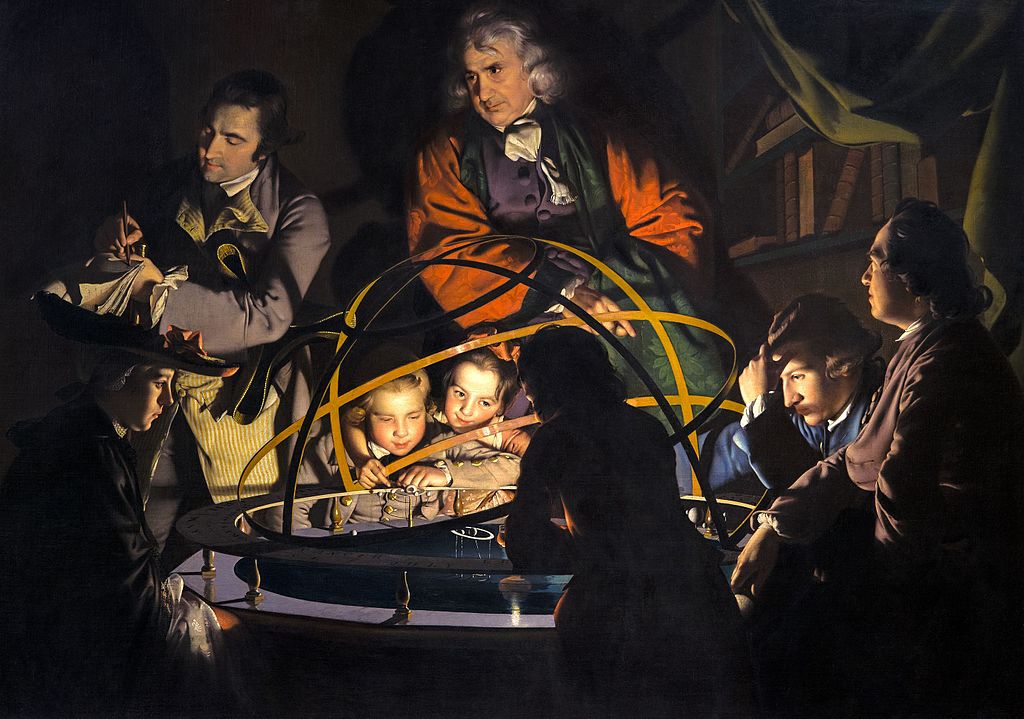A Philosopher Lecturing on the Orrery

Orreries were a popular tool in the 18th-century, both for teaching purposes and for those who could afford one for recreation at home.
Once Sir Isaac Newton’s universal theory of gravity had provided an explanation for the orbits of the planets, interest in astronomy quickly grew.
The devices were mechanical models of the solar system that showed the relative positions and motions of the planets and moons, usually with the sun occupying centre stage,
In Joseph Wright of Derby’s (1734-1797) particular example, a lamp occupies the role of the sun, lighting up the wonderment on the faces of the viewers.
The planets where usually made of ivory and mounted on brass, and a geared mechanism in the base rotated them to mimic their movements in outer space.
People had just begun to understand the world, and our place in it. Orrery demonstrations left audiences awestruck as they graphically illustrated our humble position in this ‘clockwork universe’.
This painting, which has the full title A Philosopher giving a Lecture on the Orrery in which a Lamp is put in place of the Sun, depicts the invention being presented to a small, captivated audience of young boys.
The work is rich with meaning and open to various interpretations. The gentleman taking notes is identified as Peter Perez Burdett, a friend of Wright’s and a surveyor, mathematician and artist. The philosopher is the most dominant figure in the composition, and it is believed that he was modelled on Sir Isaac Newton.
Joseph Wright’s links to the Lunar Society gave his paintings a certain scientific validity, while the artist’s dramatic use of light and exquisite brushwork demonstrated his artistic abilities.
He experimented with both natural and artificial light sources, and routinely painted the same scene several times over, as in Dovedale by Moonlight and Dovedale in Sunlight, intrigued by recording the landscape in differing conditions.
Of course, Monet would also follow this path about 100 years later with his series of identical haystacks, painted at different times of day, under cloud or in midday sun.
Wright was born in 1734 to a respectable family of lawyers and raised in Derby, but even as a young boy Joseph was mechanically-minded and curious. He would often wander around his hometown, which was to become the epicentre of Britain’s Industrial Revolution, and observe the work of the local craftsmen, and then do his best to copy them at home.
Young Wright also had an interest in drawing, and so at 17 trained with a successful portrait painter in London, Thomas Hudson, who had been Sir Joshua Reynolds’ master.
Wright started his career working on meticulously detailed portraiture, before being drawn to a circle of scientists, industrialists and academics, who began to greatly influence his work.
He soon sought to capture the mood of Britain at the time, and the growing atmosphere of progress and possibility. Clearly, Wright found working during this period of the Enlightenment to be an inspirational time.
Though the artist would often consult complex texts and diagrams when planning his pictures, he didn’t strive for painstaking scientific accuracy. He was a frequent contributor to the exhibitions of the Society of Artists and the Royal Academy, where he was elected a full member in 1784, an honour which he declined.
Wright was widely admired for his mastery of chiaroscuro – the painting technique which emphasises the contrast of light and dark, best demonstrated in his candle-lit scenes.
In A Philosopher Lecturing on the Orrery, the brightness of the single lamp floods across the faces emerging from the gloom – illuminating both the room, and symbolically, the minds of the spectators. His reference to Enlightenment philosophy is suggested by his use of light to depict logic and reason, and darkness to suggest ignorance.
Wright is perhaps also illustrating how scientific knowledge was beginning to undermine the omnipotent power of religion in Western societies.
Two years later, in his 1768 painting An Experiment on a Bird in the Air Pump a scientist is demonstrating the formation of a vacuum. An audience is gathered, including nervous children, a reflective philosopher, an excited older youth, and two lovers who appear to be more interested in themselves.
All are lit by a single candle, casting eerie shadows on the onlookers. The scientist is withdrawing air from a glass flask containing a cockatoo, leaving viewers to anxiously wonder if the bird will survive as it is being deprived of oxygen.
It obviously raised questions about science and morality that were of great concern at the dawning of the industrial revolution.
In The Alchemist we witness a scientist in a somewhat ecclesiastical-looking laboratory, seeking to discover the Philosopher’s Stone, a mystical substance that would turn any metal into gold. Working in moonlight, he discovers phosphorous glowing in his test flask, as he kneels in reverence to the wondrous material.
Wright has been acclaimed as ‘the first professional painter to express the spirit of the Industrial Revolution’, though of course he was far more. His paintings were highly detailed depictions of each of his subjects, in awe, delight, fear and anticipation; realistic, melodramatic and romantic, they were captured in flickering candlelight, or with shadows from stronger light sources playing across their features.
In his immaculately precise paintings, he in many ways echoed the breakthroughs of Caravaggio’s religious masterpiece The Calling of St Matthew. Wright also brilliantly explored the powerful effect that a single beam of light can command within a roomful of people.
Undoubtedly, Wright presented a unique pictorial summation of a nation in flux, both enraptured, and apprehensive about the tumultuous changes on the way. Few artists at any time dealt with the impact of scientific knowledge more tellingly, and none with such complete mastery of his tools – a simple paintbrush and paint.
